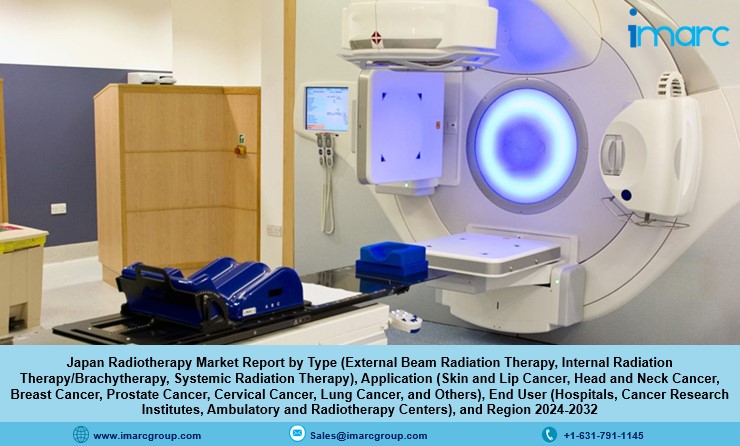IMARC Group’s report titled “Japan Radiotherapy Market Report by Type (External Beam Radiation Therapy, Internal Radiation Therapy/Brachytherapy, Systemic Radiation Therapy), Application (Skin and Lip Cancer, Head and Neck Cancer, Breast Cancer, Prostate Cancer, Cervical Cancer, Lung Cancer, and Others), End User (Hospitals, Cancer Research Institutes, Ambulatory and Radiotherapy Centers), and Region 2024-2032“. Japan radiotherapy market size is projected to exhibit a growth rate (CAGR) of 7.98% during 2024-2032.
Factors Affecting the Growth of the Japan Radiotherapy Industry:
- Rising Cancer Incidence and Aging Population:
The Japan radiotherapy market is significantly driven by the growing incidence of cancer cases, particularly among the elderly population. As the country experiences a demographic shift towards an aging society, the prevalence of cancer, a disease associated with age, continues to rise. Radiotherapy is a pivotal component of cancer treatment and management, making it indispensable in the country’s healthcare infrastructure. The rising demand for advanced radiotherapy solutions to effectively treat various cancer types that reflects the role of radiotherapy in addressing the healthcare needs of an aging and cancer-prone population is propelling the market growth.
- Ongoing Technological Advancements in Radiotherapy:
Japan’s commitment to technological innovation extends to the field of radiotherapy. Continuous developments in radiotherapy technologies, such as IMRT, SRS, and proton therapy, are driving market growth. These innovations enhance treatment precision, minimize side effects, and improve patient outcomes. Apart from this, the rising adoption of advanced radiotherapy techniques ensures that patients receive the best possible care and makes radiotherapy an attractive option for healthcare providers. The ever-evolving landscape of radiotherapy technologies reinforces its importance in Japan’s cancer treatment ecosystem, thus contributing to market growth.
- Favorable Government Initiatives and Healthcare Investments:
The Japanese government’s dedication to enhancing cancer care and treatment is a major driver of the radiotherapy market. Government-led initiatives and investments in healthcare infrastructure, including the establishment of state-of-the-art radiotherapy facilities, aim to ensure that cancer patients have access to cutting-edge treatments. This support system encourages the growth of radiotherapy services and fosters research and development (R&D) in the field. Government backing reinforces the pivotal role of radiotherapy in Japan’s comprehensive cancer treatment landscape, promoting market expansion. It underscores the commitment to improving healthcare outcomes and addressing the healthcare needs of the population effectively, thereby supporting market growth.
For an in-depth analysis, you can refer sample copy of the report: https://www.imarcgroup.com/japan-radiotherapy-market/requestsample
Japan Radiotherapy Market Report Segmentation:
By Type:
- External Beam Radiation Therapy
- Intensity-Modulated Radiation Therapy (IMRT)
- Image-Guided Radiation Therapy (IGRT)
- Tomotherapy
- Stereotactic Radiosurgery
- Stereotactic Body Radiation Therapy
- Proton Therapy
- 3D Conformal Radiotherapy (3D CRT)
- Volumetric Modulated Arc Therapy (VMAT)
- Internal Radiation Therapy/Brachytherapy
- Systemic Radiation Therapy
Based on the type, the market has been divided into external beam radiation therapy (intensity-modulated radiation therapy (IMRT), image-guided radiation therapy (IGRT), tomotherapy, stereotactic radiosurgery, stereotactic body radiation therapy, proton therapy, 3D conformal radiotherapy (3D CRT), and volumetric modulated arc therapy (VMAT)), internal radiation therapy/brachytherapy, and systemic radiation therapy.
By Application:
- Skin and Lip Cancer
- Head and Neck Cancer
- Breast Cancer
- Prostate Cancer
- Cervical Cancer
- Lung Cancer
- Others
On the basis of the application, the market has been categorized into skin and lip cancer, head and neck cancer, breast cancer, prostate cancer, cervical cancer, lung cancer, and others.
By End User:
- Hospitals
- Cancer Research Institutes
- Ambulatory and Radiotherapy Centers
The market has been segmented based on the end user into hospitals, cancer research institutes, and ambulatory and radiotherapy centers.
Regional Insights:
- Kanto Region
- Kansai/Kinki Region
- Central/ Chubu Region
- Kyushu-Okinawa Region
- Tohoku Region
- Chugoku Region
- Hokkaido Region
- Shikoku Region
Region-wise, the market has been segregated into the Kanto Region, Kansai/Kinki Region, Central/ Chubu Region, Kyushu-Okinawa Region, Tohoku Region, Chugoku Region, Hokkaido Region, and Shikoku Region.
Competitive Landscape:
Some of the key players include:
- Elekta K.K. (Elekta)
- Hitachi Ltd.
- Osaka Heavy Ion Therapy Center
- Sumitomo Heavy Industries Ltd.
- Toshiba Corporation
Japan Radiotherapy Market Trends:
The rising incidence of cancer in Japan, particularly among the aging population, has augmented the demand for advanced radiotherapy technologies and treatments, thereby stimulating market growth. Apart from this, ongoing technological advancements in radiotherapy equipment, such as intensity-modulated radiation therapy (IMRT) and image-guided radiation therapy (IGRT) that improve treatment precision and reduce side effects, have accelerated the adoption of radiotherapy. Furthermore, favorable government initiatives and investments in healthcare infrastructure and insurance coverage for cancer treatments that ensure broader access to radiotherapy services across the country are favoring market growth.
Note: If you need specific information that is not currently within the scope of the report, we will provide it to you as a part of the customization.
About Us:
IMARC Group is a leading market research company that offers management strategy and market research worldwide. We partner with clients in all sectors and regions to identify their highest-value opportunities, address their most critical challenges, and transform their businesses.
IMARCs information products include major market, scientific, economic and technological developments for business leaders in pharmaceutical, industrial, and high technology organizations. Market forecasts and industry analysis for biotechnology, advanced materials, pharmaceuticals, food and beverage, travel and tourism, nanotechnology and novel processing methods are at the top of the companys expertise.
Our offerings include comprehensive market intelligence in the form of research reports, production cost reports, feasibility studies, and consulting services. Our team, which includes experienced researchers and analysts from various industries, is dedicated to providing high-quality data and insights to our clientele, ranging from small and medium businesses to Fortune 1000 corporations.
Contact Us:
IMARC Group
Email: sales@imarcgroup.com
USA: +1-631-791-1145 | Asia: +91-120-433-0800
Address: 134 N 4th St. Brooklyn, NY 11249, USA
Follow us on Twitter: @imarcglobal



